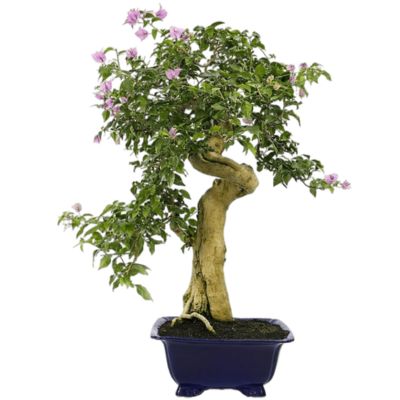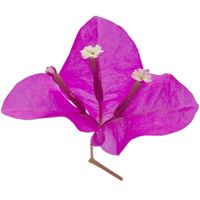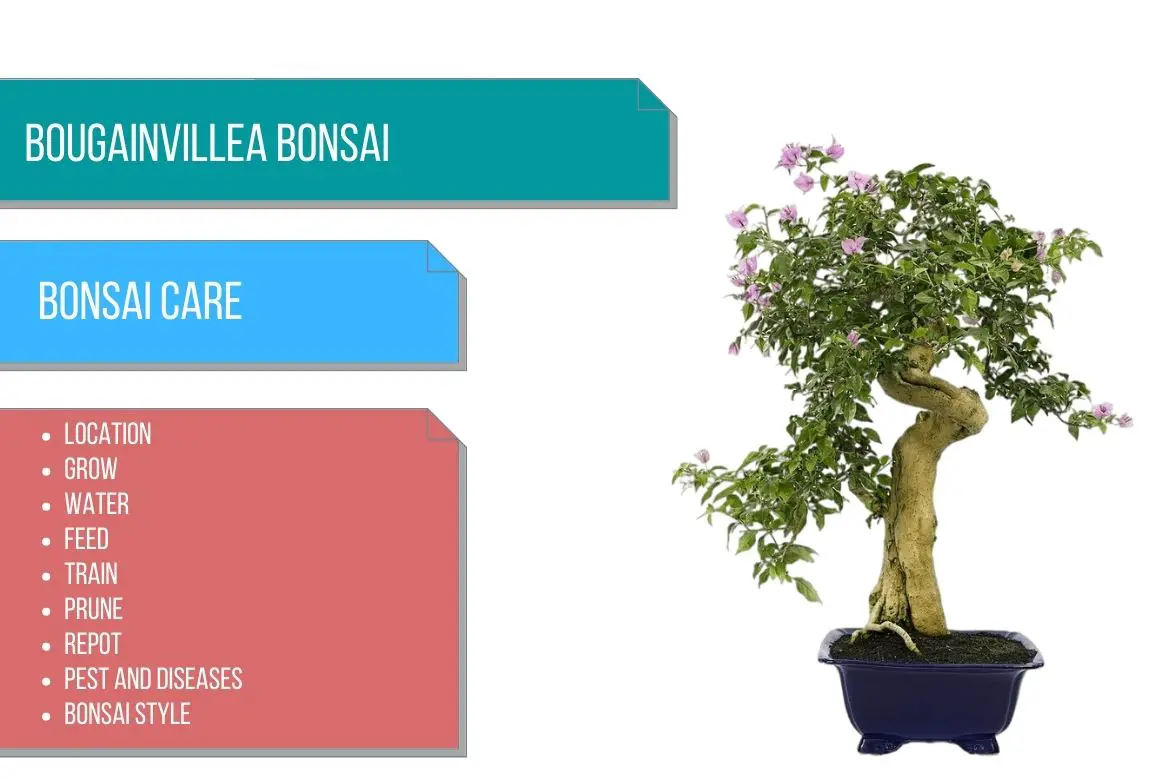
Bougainvillea
(Bougainvillea)
Country of Origin : Brazil
Bonsai Styles : Informal upright, semi-cascade, cascade
Zone : 10-11
Bougainvillea is a sub-tropical deciduous shrubby, tender and climbing plant with dark green elliptical leaves and spiny growths.
For medium to extra-large sizes, it is suitable for all styles except formal upright, broom, and literati.
This species is most popular as a bonsai or as a garden plant because of its colorful, showy bracts covering the flowers. Often mistaken for petals (in fact they are leaves), these bracts range from pure white to pink to crimson in color.
There are actually numerous variegated cultivars with leaves that are a mixture of greens and yellows. However, they tend to be less robust than green-leaved cultivars and are not traditionally used for bonsai in Japan.
Because it has very rigid branches and twigs, bonsai can be usually shaped by simple pruning techniques.
The roots of the tree are pruned to a length of few inches. The roots will grow very fast in the bonsai pot.
The smallest bougainvilleas grow best as full- or semi-cascades, or as literati (long-trunked) varieties.
For more normal tree-like shapes, these large leaves and bracts are not suitable.
Few varieties of Bougainvillea are B. glabra, B. spectabilis, B. buffiana and B. buffiana.
Bougainvillea glabra, or paper flower, is an evergreen or semi-evergreen rambling climber that bears clusters of purple-colored bracts in the summer.

For all other bonsai tree species you can grow, please read : Types of bonsai trees
Best location keep Bougainvillea Bonsai
The Bougainvillea thrive in full sun indoors or outdoors throughout the summer. Continue reading do bonsai trees need sunlight for more indoor and outdoor bonsai location ideas. Also, continue reading about indoor bonsai tree care.
If you are planning to keep it indoors, keep it in a south facing window where it will receive as much light as possible. The more light the plant will receive, the better the flowering. You can also use led grow lights for indoor settings.
Bougainvillea plant requires a light level of at-least 2000 LUX. Continue reading Use grow-light to grow bonsai indoors.
However, if the plant is outside, it is more difficult to control the water, which may result in inconsistent flowering.
In the hottest part of the day, the hot sun through window glass is magnified, so some light shading, like an open-weave net curtain can keep the plant in good shape. Continue reading about Outdoor bonsai tree care.
The ideal temperature for Bougainvillea plant is 65°F to 75°F (18°C to 24°C).
In the winter, try and keep the plant in a temperature range of 46-59°F (8-15°C). The plant will not be able to tolerate temperatures below 45°F. Continue reading Bougainvillea Bonsai Winter Care.
One of the signs that the Bougainvillea plant is cold is that it will shed its leaves. Don’t panic and over the plant to a warmer place. Bougainvillea is a resilient plant, it will recover soon.
Propagation Bougainvillea
Bougainvillea can be propagated via stem or root cuttings. For more details, continue reading Growing Bougainvillea Bonsai from Cuttings.
Summer and spring season are considered as the appropriate time to propagate Bougainvillea. You can use both softwood or hardwood cuttings.
It can be propagated through air layering also.
Watering Bougainvillea Bonsai
Similar to bad lighting and temperature, Bougainvillea also sheds its leaves in case it receives less water. As soon as you see this, water the plant immediately.
Maintain an even moisture level in the soil for bougainvillea.
You don’t want to over-water your bougainvillea, but at the same time you don’t want the leaves to go limp due to too much drying.
In summers, water frequently (may be daily).
When watering in the winter, allow the surface of the compost to dry a little before watering. You can even reduce the frequency of watering in winter (depending on the climate) to once every 2 to 3 weeks.
In winter, it is possible for soil surfaces to be bone dry, but moisture beneath will darken the color of the soil.
When the buds begin to grow in spring, add plenty of water so the compost stays moist, but not soggy.
When a room’s environment is very dry, it is advisable to mist.
If the plant goes dormant, reduce watering.
If you want to induce flowering in summer, you need to dry the bonsai out and let it wilt for 3 to 4 hours before you begin watering normally.
One or two weeks after wilting, you can expect flower production to begin.
Continue reading about how to water a bonsai tree.
Wiring Bougainvillea Bonsai
It should not be necessary to wire because pruning is the most effective way to shape Bougainvillea plant.
However, if needed you can use aluminum wires for wiring since the Bougainvillea branches are too brittle.
On the other hand, it is relatively easier to wire young shoots as they are somewhat flexible.
Be careful of the thorns.
Please read our detailed guide on how to wire a bonsai tree. Also, refer to our detailed bonsai tools guide and how to take proper care of your bonsai tools to know about all the tools of bonsai.
Pruning Bougainvillea Bonsai
When to prune Bougainvillea bonsai?
When the plant is semi-dormant (in winters), branch pruning can be performed at any time.
After flowering, prune the current season’s growth (in early fall). This will also encourage new growth.
Spring growth should be left unchecked until the first few leaves are hardened, at which time they should be cut to one or two leaves.
Flowers will appear in the next flush of growth.
If you prune too early, you’ll induce too much vegetative growth; pruning too late will delay flowering.
In the growing season, remove large leaves.
In midsummer, cutting all leaves encourages small leaves.
Bougainvillea needs pruning only when the bonsai is actively growing.
Plants can easily get overgrown and are best pruned back hard to maintain their shape.
It is best to carve thick trunks to resemble nature’s hollow trunks in spring and summer when cuts heal well.
Stop pruning at the end of the growing season.
Refer to how to prune a bonsai tree for more info on best practices and tips and tricks.
Pinching Bougainvillea Bonsai
If you continue to pinch out the new growth, you will have no bracts next year.
Repotting Bougainvillea Bonsai
When to repot Bougainvillea bonsai?
It is best to repot bougainvilleas only every three or four years as they do best when they are potbound.
Late spring is the best time for repotting.
The roots of the plant do not develop into strong fibrous balls until the Bougainvillea plant is quite mature.
In case you are pruning the roots, try to keep as many fibrous roots as you can.
When you repot, don’t remove more than one-third of the roots. It takes the plant quite a while to develop a strong fibrous root ball.
Plant into a mix of akadama and lava or pumice, in equal proportions OR use free-draining bonsai soil mix OR loam-based, free-draining compost.
Add a drainage layer of larger lava or pumice.
You can read how to repot a bonsai tree to know more about the best guidelines to follow while repotting.
Also, continue reading about how to make bonsai soil at home and how to choose a pot for your bonsai.
Feeding Bougainvillea Bonsai
Plants can be encouraged to flower by applying an organic fertilizer or a low-nitrogen fertilizer, only during the growing season every month.
A fertilizer for rose of tomato can be used for Bougainvillea bonsai tree.
OR
Every week, apply a half strength fertilizer that is well balanced.
The color of bracts may be improved with chelated iron.
The Bougainvillea plant thrives in acidic soil, so fertilize the soil once a month with half strength azalea and camellia fertilizers.
Continue reading about bonsai fertilizer and its application.
Diseases and pest of Bougainvillea Bonsai
All the insect pests – aphids, scale insects, and red spider mites – affect Bougainvilleas.
The aphids can be picked off by hand and red spider mites can be controlled through misting, however, it is best to use systemic insecticides to control severe infestations.
Powdery mildew can also occur in Bougainvillea if good soil conditions are not maintained.
Refer the in-depth guide for bonsai pest and diseases identification and treatment for more details.
Also, read best practices to keep your bonsai pest free.
Bougainvillea bonsai care
Bougainvilleas that are moved from one environment to another without gradual acclimatization are prone to defoliation and may not bloom. The new environment should be introduced gradually over a period of almost two weeks.
After acclimatization, bougainvilleas can be kept outdoors in temperate zones.
The best growth for Bougainvillea bonsai is when their roots are kept well insulated from the heat while the plant receives good light. By using a deep container, and by adding lots of fibrous organic matter, this can be accomplished. However, too much fibrous material can be a problem as it will retain more moisture and can cause root rot.
Flowering and colorful bracts will also be diminished by insufficient light, too much water, or too little water.
Once spring growth has begun, move the plant to a spot where it will receive direct morning sun and good overhead lighting for the rest of the day. At this time, increase the amount of water so that the soil becomes evenly moist without becoming waterlogged.
What to look for when buying Bougainvillea Bonsai
The bougainvillea plant grows in a straggly manner in nature, but older plants develop a very thick trunk base if all suckers (growths that emerge from roots or trunk bases) are removed as soon as they appear.
It takes a lot of time and effort to train thick Bougainvillea trunks as bonsai, so the final product is typically expensive.
It is essential that you look for an interesting, unscarred trunk and branches that are free of old wire marks if you can afford a large specimen. If necessary, you can prune and replace the secondary branches.
While smaller, less well-developed specimens are sometimes available at reasonable prices, they rarely become larger trees when confined to a pot.
During the colder months, don’t buy bougainvillea if it’s lost its leaves or isn’t firm in its pot (signs of root decay).


